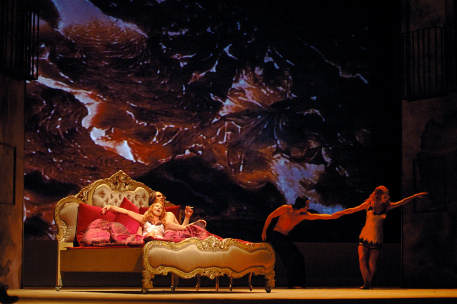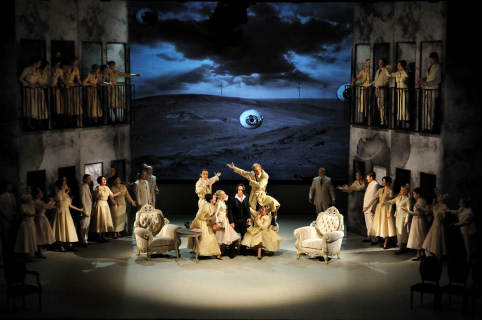Other Links
Editorial Board
- Editor - Bill Kenny
Founder - Len Mullenger
Google Site Search
SEEN
AND HEARD INTERNATIONAL OPERA REVIEW
Mari Vihmand, The Formula of Love : at the Estonian National Opera 17.10.2008. World Premiere. (GF)
Libretto by
Mari Vihmand and Maimu Berg after the novel The Mathematics of
Nina Gluckstein
Concept and dramaturgy: Mari Vihmand and Liis Kolle
Stage Director: Liis Kolle
Designer: Ann Lumiste
Lighting designer: Airi Eras
Choreographer: Ana Mondini
Cast:
Nina
Gluckstein – Helen Lokuta (mezzo-soprano)
Domestic Estonian opera is in good health. In June 2007 Erkki-Sven
Tüür’s anti-fascist opera Wallenberg was premiered at the
Estonian National Opera and has been – and still is – a great
success. That opera was originally commissioned by Dortmund Opera in
2001 but Mari Vihmand’s The Formula of Love is a work
specifically written for the National Opera and judging from the
world premiere last Friday it has all the prerequisites of having a
long run too.
Visually it is also an enticing production with suggestive lighting
effects, projections and scenes gliding seamlessly over into the
next one. Nina and Chucho have alter egos in the shape of
ballet dancers, sometimes appearing simultaneously with the ‘real’
characters, mirroring their feelings. This is especially
psychologically expressive in the scene where Nina is waiting for
Chucho to arrive home and in the meantime reading magazines and
newspapers, where scandalous and insulting things are
said about her. Outwardly she seems calm,
controlled, in spite of the slander that she relates, but her
alter ego expresses much more palpably the fury and despair that
rages within her.
Chucho
Santelmo – René Soom (baritone)
Roberta Gómez Dawson – Riina Airenne (mezzo-soprano)
First journalist – Angelika Mikk (coloratura soprano)
Second
journalist – Janne Ševtšenko (soprano)
Third journalist – Juuli Lill (mezzo-soprano)
Fourth
journalist – Andres Köster (tenor)
Fifth journalist – Priit Volmer (bass)
Estonian National Opera Chorus and Orchestra / Arvo Volmer

The story, based on Esther Vilar’s bestselling novel, deals with
universal questions like artists’ integrity and eternal love,
projected against the unhappy love story of Argentinean tango singer
Chucho Santelmo and Nina Gluckstein and also the old poet Roberta
Gómez Dawson and her unsuccessful love relationship,
a kind of parallel which we get to know in the shape of fragments
interwoven in the central story. It is a tragedy and we are informed
of the outcome from the beginning. After the short overture,
rhythmically jagged and built on short motifs, gradually becoming
motorically insistent, Nina, all dressed in white,
sings a mourning song in Spanish with the message ‘never will I
see your eyes again’ whereupon she shoots herself with her
silver pistol. The chorus somewhat later relates what happened to
her husband, which means that the rest of the opera is a series of
flashbacks, presented in the shape of a number opera.
Although it is a tragedy,
it doesn’t exclude moments of humour and
even satirical elements, most notably the merciless drive of the
journalists against Nina – and also Chucho – under the motivation
that ‘we represent our readers, we ask what interests them’.
The music is utterly cantabile, tailored for the soloists and
unabashedly romantic without a trace of sentimentality. This does
not by definition imply that Mari Vihmand rubs the audience
up the right way all the time. The
harmonic garb is rather bold and the orchestration inventive and
colourful with many instrumental solo contributions. The general
idiom is modern but held within accessible tonality:
many of the vocal solos are achingly
beautiful. Most impressive of all though
is the choral writing. The chorus has a very central role in this
opera, from dramatically participating crowds to more abstractly
commenting functions. Some of their contributions are in fact more
oratorio like than operatic – which is in no way a negative feature.
In fact, an opera that ends with the loving couple, dressed in
white, performing a trapeze act, presumably in “The undiscover’d
country, from whose bourn No traveller returns”, has more than a
whiff of oratorio about it. Within
the drama, there are also incorporated
quotations from Oscar Wilde and Ovid, which are sung evocatively, in
the original languages, by the chorus.
The main male character is a tango singer but The Formula of Love
is decidedly not a tango opera. There are scenes where tango
is unavoidable, like Chucho’s two songs in the second act and the
above mentioned trapeze sequence and Mari Vihmand even makes use of
Astor Piazzolla’s prelude to Ballada para mi muerte, but
otherwise there are no direct references to the geographical setting
of the opera. The accordionist, Jaak Lutsoja, has an important role,
musically as well as scenically, walking on at
the beginning of the opera in the stalls
in front of the orchestra pit and later
appearing on stage.

The performance on the first night was a strong one with excellent
playing from the orchestra and the chorus obviously relishing in
their great numbers. Helen Lokuta sang and acted Nina Gluckstein as
to the manner born: stylish, elegant, charismatic and singing
magnificently. René Soom also had the appearance of a star in the
public scenes and the warmth of an affectionate lover in the private
ones. Vocally he also impressed, most of all in the restrained
singing of his final song – after his demise – delivered from one of
the boxes. Riina Airenne, with an impressive list of important roles
to her credit, was an expressive and believable Roberta. Some
tendencies to loosened vibrato may be ascribed to the fact that her
character is supposed to be around 80. The five journalists were
just as nasty as one could expect from some of that species. They
sing mostly as a group but were also excellent individually with the
mighty bass voice of Priit Volmer, whom I have praised on several
occasions before, standing out especially.
Göran Forsling
An interview with the composer
Mari Vihmand
will follow on October 28th.
Pictures © Estonian National Opera, Harri Rospu
Back
to Top
Cumulative Index Page
